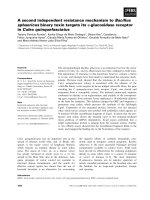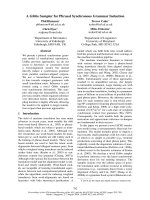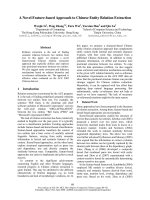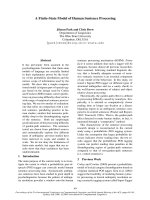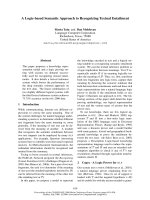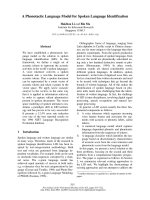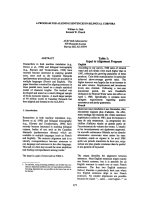Báo cáo khoa học: "A SIMPLE BUT USEFUL APPROACH TO CONJUNCT IDENTIFICATION" docx
Bạn đang xem bản rút gọn của tài liệu. Xem và tải ngay bản đầy đủ của tài liệu tại đây (545.56 KB, 7 trang )
A SIMPLE BUT USEFUL APPROACH TO CONJUNCT IDENTIFICATION 1
Rajeev Agarwal
Lois Boggess
Department of Computer Science
Mississippi State University
Mississippi State, MS 39762
e-mail:
ABSTRACT
This paper presents an approach to identifying
conjuncts of coordinate conjunctions appearing in
text which has been labelled with syntactic and
semantic tags. The overall project of which this
research is a part is also briefly discussed. The
program was tested on a 10,000 word chapter of
the Merck Veterinary Manual. The algorithm is
deterministic and domain independent and it
performs relatively well on a large real-life
domain. Constructs not handled by the simple
algorithm are also described in some detail.
INTRODUCTION
Identification of the appropriate conjuncts
of the coordinate conjunctions in a sentence is
fundamental to the understanding of the sentence.
We use the phrase 'conjunct identification' to
refer to the process of identifying the components
(words, phrases, clauses) in a sentence that are
conjoined by the coordinate conjunctions in it.
Consider the following sentence:
"The president sent a memo to the
managers to inform them of the tragic
inciden[ and to request their co-
operation."
In this sentence, the coordinate conjunction 'and'
conjoins the infinitive phrases "to inform them
of the tragic incident" and "to request their co-
operation". If a natural language understanding
system fails to recognize the correct conjuncts, it
is likely to misinterpret the sentence or to lose
its meaning entirely. The above is an example
of a simple sentence where such conjunct
identification is easy. In a realistic domain, one
encounters sentences which are longer and far
more complex.
1 This work is supported in part by the National
Science Foundation under grant number IRI-9002135.
This paper presents an approach to
conjunct identification which, while not perfect,
gives reasonably good results with a relatively
simple algorithm. It is deterministic and
domain independent in nature, and is being tested
on a large domain - the Merck Veterinary
Manual, consisting of over 700,000 words of
uncontrolled technical text. Consider this
sentence from the manual:
"The mites live on the surface of the
skin of the ear and canal, and feed by
piercing the skin and sucking lymph,
with resultant irritation,
inflammation, exudation, and crust
formation".
This sentence has four coordinate conjunctions;
identification of their conjuncts is moderately
difficult. It is not uncommon to encounter
sentences in the manual which are more than
twice as long and even more complex.
The following section briefly describes the
larger project of which this research is a part.
Then the algorithm used by the authors and its
drawbacks are discussed. The last section gives
the results obtained when an implementation was
run on a 10,000-word excerpt from the manual
and discusses some areas for future research.
THE RESEARCH PROJECT
This research on conjunct identification is a
part of a larger research project which is
exploring the automation of extraction of
information from structured reference manuals.
The largest manual available to the project in
machine-readable form is the Merck Veterinary
Manual, which serves as the primary testbed.
The system semi-automatically builds and
updates its knowledge base. There are two
components to the system - an NLP (natural
language processing) component and a knowledge
analysis component. (See Figure 4 at the end.)
15
The NLP component consists of a tagger, a
semi-parser, a prepositional phrase attachment
specialist, a conjunct identifier for coordinate
conjunctions, and a restructurer. The tagger is a
probabilistic program that tags the words in the
manual. These tags consist of two parts - a
mandatory syntactic portion, and an optional
semantic portion. For example: the word
'cancer' would be tagged as noun//disorder, the
word 'characterized' would be verb~past_p, etc.
The semantic portion of the tags provides
domain-specific information. The semi-parser,
which is not a full-blown parser, is responsible
for identifying noun, verb, prepositional, gerund,
adjective, and infinitive phrases in the sentences.
Any word not captured as one of these is left as a
solitary 'word' at the top level of the sentence
structure. The output produced by the semi-
parser has very little embedding and consists of
very simple structures, as will be seen below.
The prepositional phrase attachment
disambiguator and the conjunct identifier for
coordinate conjunctions are considered to be
"specialist" programs that work on these simple
structures and manipulate them into more deeply
embedded structures. More such specialist
programs are envisioned for the future. The
restructurer is responsible for taking the results
of these specialist programs and generating a
deeper structure of the sentence. These deeper
structures are passed on to the knowledge
analysis component.
The knowledge analvsis comnonent is
responsible for extracting from these structures
several kinds of objects and relationships to build
and update an object-oriented knowledge base.
The system can then be queried about the
information contained in the text of the manual.
This paper primarily discusses the conjunct
identifier for coordinate conjunctions. Detailed
information about the other components of the
system can be found in [Hodges et al., 1991],
[Boggess et al., 1991], [Agarwal, 1990], and
[Davis, 1990].
CONJUNCT IDENTIFICATION
The program assigns a case label to every
noun phrase in the sentence, depending on the
role that it fulfills in the sentence. A large
proportion of the nouns of the text have semantic
labels; for the most part, the case label of a
noun phrase is the label associated with the head
noun of the noun phrase. In some instances, a
preceding adjective influences the case label of
the noun phrase, as, for example, when an
adjective with a semantic label precedes a generic
noun. A number of the resulting case labels for
noun phrases (e.g. time, location, etc.)are
similar those suggested by Fillmore [1972], but
domain dependent case labels (e.g. disorder,
patient, etc.) have also been introduced. For
example: the noun phrase "a generalized
dermatitis" is assigned a case label of disorder,
while "the ear canal" is given a case label of
body_part. It should be noted that, while the
coordination algorithm assumes the presence of
semantic case labels for noun phrases, based on
semantic tags tor the text, it does not depend on
the specific values of these labels, which change
from domain to domain.
THE ALGORITHM
The algorithm makes the simplifying
assumption that each coordinate conjunction
conjoins only two conjuncts. One of these
appears shortly after the conjunction and is called
the post-conjunct, while the other appears
earlier in the sentence and is referred to as the
pre-conjunct.
The identification of the post-conjunct is
fairly straightforward: the first complete phrase
that follows the coordinate conjunction is
presumed to be the post-conjunct. This has been
found to work in all of the sentences on which
this algorithm has been tested. The identification
of the pre-conjunct is somewhat more
complicated. There are three different levels of
rules that are tried in order to find the matching
pre-conjunct. These are referred to as level-l,
level-2, and level-3 rules in decreasing order of
importance. The steps involved in the
identification of the pre- and the post-conjunct are
described below.
(a) The sentential components (phrases or
single words not grouped into a phrase by the
parser) are pushed onto a stack until a coordinate
conjunction is encountered.
(b) When a coordinate conjunction is
encountered, the post-conjunct is taken to be the
immediately following phrase, and its type (noun
phrase, prepositional phrase, etc.) and case label
are noted.
(c) Components are popped off the stack,
one at a time, and their types and case labels are
compared with those of the post-conjunct. For
each component that is popped, the rules at level-
1 and level-2 are tried first. If both the type and
case label of a popped component match those of
the post-conjunct (level-I rule), then this
component is taken to be the pre-conjunct.
Otherwise, if the type of the popped component
is the same as that of the post-conjunct and the
case label is compatible (case labels like
medication and treatment, which are semantically
16
sentence([
noun_phrase(ease_label(body_part}, [(~h¢, det), (¢~r, noun I body_part)])
verb_phrase([(should, aux), (be, aux), (cleaned, verb l past_p)l)
prep_phrase([(by, prep),
gerund_phrase([(flushing, verb I gerund)I)1)
word([(away, advl Ilocation)])
noun_phrase(ease label{unknown), [(the, det), (debris, noun)])
word([(and, conj I co ord)])
noun_phrase(ease_label{body_fluld), [(exudate, noun l I body_fluid)])
gerund_phrase([(using, verb I gerund),
noun_phrase(ease_label{medication}, [(warm, adj), (saline,
adj I I medication), (solution, noun l I medication)])])
word([(or, conj I co_ord)])
noun phrase(ease_label{unknown), [(water, noun)])
prep_phrase([(with, prep),
noun phrase(ease_label{medication), [(a, det), (very, adv I degree),
(dilute, adj I I degree), (germicidal, adj I I medical),
(detergent, noun I I medication)])])
word([(comma, punc)])
word([(and, conj I co_ord)])
noun_phrase(case_label{body_part), [(the, det), fcanal, noun l I body_part)])
verb_phrase([(dried, verb I past p)])
word([(as, conj I correlative)I)
word([(gently, adv)])
word([(as, conj I correlative)])
adj_phrase([(possible, adj)])
]).
Figure 1
similar, are considered to be compatible) to that
of the post-conjunct (level-2 rule), then this
component is identified as the pre-conjunct. If
the popped component satisfies neither of these
rules, then another component is popped from
the stack and the level- 1 and level-2 rules are tried
for that component.
(d) If no component is found that satisfies
the level-1 or level-2 rules and the beginning of
the sentence is reached (popping components off
the stack moves backwards through the sentence),
then the requirement that the case label be either
the same or compatible is relaxed. The
component with the same type as that of the
post-conjunct (irrespective of the case label) that
is closest to the coordinate conjunction, is
identified as the pre-conjunct (level-3 rule).
(e) If a pre-conjunct is still not found, then
the post-conjunct is conjoined to the first word in
the sentence.
Although there is very little embedding of
phrases in the structures provided by the semi-
parser, noun phrases may be embedded in
prepositional phrases, infinitive phrases, and
gerund phrases on the stack. The algorithm does
permit noun phrases that are post-conjuncts to be
conjoined with noun phrases embedded as objects
of, say, a previous prepositional phrase (e.g., in
the sentence fragment "in dogs and cats", the
noun phrase 'cats' is conjoined with the noun
phrase 'dogs' which is embedded as the object of
the prepositional phrase 'in dogs'), or other
similar phrases.
We have observed empirically that, at least
for this fairly carefully written and edited manual,
long distance conjuncts have a strong tendency to
exhibit high degrees of parallelism. Hence,
conjuncts that are physically adjacent may merely
be of the same syntactic type (or may even be
syntactically dissimilar); as the distance between
conjuncts increases, the degree of parallelism
tends to increase, so that conjuncts are highly
likely to be of the same semantic category, and
syntactic and even lexical repetitions are to be
found (e.g., on those occasions when a post-
conjunct is to be associated with a prepositional
phrase that occurs 30 words previous, the
preposition may well be repeated). The gist of
the algorithm, then, is as follows: to look for
sentential components with the same syntactic
and semantic categories as the post-conjunct, first
nearby and then with increasing distance toward
the beginning of the sentence; failing to find
such, to look for the same syntactic category,
17
sentence([
prep_phrase([(with, prep),
noun_phrase([(persistent, adjll time), (or, conjlco_ord), (untreated, adj),
(otitis_externa, noun I I disorder)I)])
word([(comma, pune)])
noun phrase([(the, det), (epithelium, noun)])
prep_phrase([(of, prep),
noun phrase([(the, det), (ear, noun I I body_part),
(canal, noun l I body_part)])])
verb_phrase([(undergoes, verb 13sg)])
noun_phrase([(hypertrol~hy, noun I I disorder)])
word([(and, eonj I co_ord)])
verb_phrase([(becomes, verb I beverb 13sg)])
adj_phrase([(fibroolastie, adj I I disorder)])
]).
Figure 2
first close at hand and then with increasing
distance, and if all else fails to default to the
beginning of the sentence as the pre-conjunct (the
semi-parser does not recognize clauses as such,
and there may be no parallelism of any kind
between the beginnings of coordinated clauses).
Provisions must be made for certain kinds of
parallelism which on the surface appear to be
syntactically dissimilar - for example, the near-
equivalence of noun and gerund phrases. In the
text used as a testbed, gerund phrases are freely
coordinated with noun phrases in virtually all
contexts. Our probabilistic labelling system is
currently being revised to allow the semantic
categories for nouns to be associated with
gerunds, but at the time this experiment was
conducted, gerund phrases were recognized as
conjuncts with nouns only on syntactic grounds -
a relatively weak criterion for the algorithm.
Further, there are instances in the text where
prepositional phrases are conjoined with
adjectives or adverbs - the results reported here do
not incorporate provisions for such. Consider
the sentence "The ear should be cleaned by
flushing away the debris and exudate using warm
saline solution or water with a very dilute
germicidal detergent, and the canal dried as gently
as possible." The semi-parser produces the
structure shown in Figure 1. The second 'and'
conjoins the entire clause preceding it with the
clause that follows it in the sentence. Although
the algorithm does not identify clause conjuncts,
it does identify the beginnings of the two
clauses, "the ear" and "the canal", as the pre- and
post-conjuncts, in spite of several intervening
noun phrases. This is possible because the case
labels of both these noun phrases agree (they arc
both
body_part).
18
THE DRAWBACKS
Before reporting the results of an
implementation of the algorithm on a 10,000
word chapter of the Merck Veterinary Manual we
describe some of the drawbacks of the current
implementation.
(i) The algorithm assumes that a coordinate
conjunction conjoins only two conjuncts in a
sentence. This assumption is often incorrect. If
a construct like [A, B, C, and D] appears in a
sentence, the coordinate conjunction 'and'
frequently, but not always, conjoins all four
components. (B, for example, could be
parenthetical.) The implemented algorithm looks
for only two conjuncts and produces a structure
like [A, B, [and [C, DIll, which is counted as
correct for purposes of reporting error rates
below. Our "coordinate conjunction specialist"
needs to work very closely with a "comma
specialist" - an as-yet undeveloped program
responsible for, among other things, identifying
parallelism in components separated by commas.
(ii) The current semi-parser recognizes
certain simple phrases only and is unable to
recognize clause boundaries. For the conjunct
identifier, this means that it becomes impossible
to identify two clauses with appropriate extents
as conjuncts. The conjunct identifier has,
however, been written in such a way that
whenever a "clause specialist" is developed, the
final structure produced should be correct.
Therefore, the conjunct identifier was held
responsible for correctly recognizing only the
beginnings of the clauses that are being
conjoined.
Similarly,
for
phrases not explicitly
recognized by the semi-parser, the current
conjunct specialist is expected only to conjoin
the beginnings of the phrases - not to somehow
bound the extents of the phrases. Consider the
sentence([
noun_phrase([(antibacterial, adj I I medication),
(drugs,noun I plurall I medication)])
verb_phrase([(administered, verb I past_p)])
prep_phrase([(in, prep),
noun_phrase([(the, det),(feed, noun)])])
verb phrase([(appeared, verb l beverb)])
inf_phrase([(to, infinitive), verb_phrase([(be, verb lbeverb)]),
adj_phrase([(effective, adj)])l)
prep_phrase([(in, prep),
noun_phrase([(some, adj I I quantity),
(herds, noun lplural I I patient)])])
word([w(and, conj I co_ord)])
prep_phrase([(with out, prep),
noun_phrase([fbenefit, noun)])])
prep_phrase([(in, prep),
noun_phrase([(others, pro I plural)])])
]).
Figure 3
sentence "With persistent or untreated otitis
externa, the epithelium of the ear canal undergoes
hypertrophy and becomes fibroplastic." The
structure received by the coordination specialist
from the semi-parser is shown in Figure 2. In
this sentence, the components "undergoes
hypertrophy" and "becomes fibroplastic" are
conjoined by the coordinate conjunction 'and'.
The conjunct identifier only recognizes the verb
phrases "undergoes" and "becomes" as the pre-
and post-conjuncts respectively and is not
expected to realize that the noun phrases
following the verb phrases are objects of these
verb phrases.
(iii) Although it is generally true that the
components to be conjoined should be of the
same type (noun phrase, infinitive phrase, etc.),
some cases of mixed coordination exist. The
current algorithm allows for the mixing of only
gerund and noun phrases. Consider the sentence
"Antibacterial drugs administered in the feed
appeared to be effective in some herds and
without benefit in others." The structure that the
coordination specialist receives from the semi-
parser is shown in Figure 3. Note that the
prepositional phrases are eventually attached to
their appropriate components, so that the phrase
"in some herds" ultimately is attached to the
adjective "effective". The system does not
include any rule for the conjoining of
prepositional phrases with adjectival or adverbial
phrases. Hence the phrases "effective in some
herds" and "without benefit in others" were not
conjoined.
RESULTS AND FUTURE WORK
The algorithm was tested on a 10,000 word
chapter of the Merck Veterinary Manual. The
results of the tests are shown in Table 1. We are
satisfied with these results for the following
reasons:
(a) The system is being tested on a large
body of uncontrolled text from a real domain.
(b) The conjunct identification algorithm is
domain independent. While the semantic labels
produced by the probabilistic labelling system are
domain dependent, and the rules for generalizing
them to case labels for the noun phrases contain
some domain dependencies (there is some
evidence, for example, that a noun phrase
Table 1:
Con i unction
and
Or
but
TOTAL
Results of the algorithm on the 'Eye and Ear' chapter
Total Cases Cowect Cases Percenm~e
366 305 83.3%
137 109 79.6%
41 30 73.2%
544 444 81.6%
19
consisting of a generic noun preceded by a
semantically labelled modifier should not always
receive the semantic label of the modifier) the
conjunct specialist pays attention only to
whether the case labels match - not to the actual
values of the case labels.
(c) The true error rate for the simple
conjunct identification algorithm alone is lower
than the 18.4% suggested by the table, and
making some fairly obvious modifications will
make it lower still. The entire system is
composed of several components and the errors
committed by some portions of the system affect
the error rate of the others. A significant
proportion of the errors committed by the
conjunct identifier are due to incorrect tagging,
absence of semantic tags for gerunds, improper
parsing, and other matters beyond its control.
For example, the fact that gerunds were not
marked with the semantic labels attached to
nouns has resulted in a situation where any
gerund occurring as post-conjunct is
preferentially conjoined with any preceding
~eneric noun. More often than not, the gerund
should have received a semantic tag and would
properly be conjoined to a preceding non-generic
noun phrase that would have been of the same
semantic type. (The conjunction specialist is not
the only portion of the system which would
benefit from semantic tags on the gerunds; the
system is currently under revision to include
them.)
From an overall perspective, the conjunct
identification algorithm presented above seems to
be a very promising one. It does depend a lot
upon help received from other components of the
system, but that is almost inevitable in a large
system. The identification of conjuncts is vital
to every NLP system. However, the authors
were unable to find references to any current
system where success rates were reported for
conjunct identification. We believe that the
reason behind this could be that most systems
handle this problem by breaking it up into
smaller parts. They start with a more
sophisticated parser that takes care of some of the
conjuncts, and then employ some semantic tools
to overcome the ambiguities that may still exist
due to co-ordinate conjunctions. Since these
systems do not have a "specialist" working
solely for the purpose of conjunct identification,
they do not have any statistic about the success
rate for it. Therefore, we are unable to compare
our success rates with those of other systems.
However, due to the reasons given above, we feel
that an 81.6% success rate is satisfactory.
We have noted several other modifications
that would improve performance of the conjunct
specialist. For example, it has been noticed that
the coordinate conjunction 'but' behaves
sufficiently differently from 'and' and 'or' to
warrant a separate set of rules. The current
algorithm also ignores lexical parallelism (direct
repetition of words already employed in the
sentence), which the writers of our text frequently
use to override plausible alternate readings. The
current algorithm errs in most such contexts. As
mentioned above, the algorithm also needs to
allow prepositional phrases to be conjoined with
adjectives and adverbs in some contexts. Some
attempt was made to implement such mixed
coordination as a last level of rules, level-4, but
it did not meet with a lot of success.
FUTURE RESEARCH
In addition to the above, the most
important step to be taken at this point is to
build the comma specialist and clause recognition
specialist. Another problem that needs to be
addressed involves deciding priorities when one or
more prepositional phrases are attached to oneof
the conjuncts of a coordinate conjunction. For
example, we need to decide between the structures
[[A and B] in dogs] and [A and [B in dogs]],
where A and B are typically large structures
themselves, A and B should be conjoined, and 'in
dogs' may appropriately be attached to B. It is
not clear whether the production of the
appropriate structure in such cases rightfully
belongs to the knowledge analysis portion of our
system, or whether most such questions can be
answered by the NLP portion of our system with
the means at its disposal. Further, the basic
organization of the NLP component, with the
tagger and the semi-parser generating the flat
structure and then the various specialist programs
working on the sentence structure to improve it,
looks a lot like a blackboard system architecture.
Therefore, one of the future ventures could be to
try to look into some blackboard architecture and
assess its applicability in this system.
Finally, there are ambiguities inherently
associated with coordinate conjunctions,
including the problem of differentiating between
"segregatory" and "combinatory" use of
conjunctions [Quirk et al., 1982] (e.g. "fly and
mosquito repellants" could refer to 'fly' and
'mosquito repellants' or to 'fly repellants' and
'mosquito repcllants'), and the determination of
whether the 'or' in a sentence is really used as an
'and' (e.g. "dogs with glaucoma or
keratoconjunctivitis will recover" implies that
dogs with glaucoma and dogs with
keratoconjunctivitis will recover). The current
algorithm does not address these issues.
20
REFERENCES
Agarwal, Rajeev. (1990). "Disambiguation
of prepositional phrase attachments in English
sentences using case grammar analysis." MS
Thesis, Mississippi State University.
Boggess, Lois; Agarwal, Rajeev; and Davis,
Ron. (1991). "Disambiguation of prepositional
phrases in automatically labeled technical text."
In
Proceedings of the Ninth National Conference
on Artificial Intelligence:l:
155-9.
Davis, Ron. (1990). "Automatic text
labelling system." MCS project report,
Mississippi State University
Fillmore, Charles J. (1972). "The case for
case." Universals in Linguistic Theory, Chicago
Holt, Rinehart & Winston, Inc. 1-88.
Hodges, Julia; Boggess, Lois; Cordova,
Jose; Agarwal, Rajeev; and Davis, Ron. (1991).
"The automated building and updating of a
knowledge base through the analysis of natural
language text." Technical Report MSU-910918,
Mississippi State University.
Quirk, Randolph; Grcenbaum,,Sidney;
Leech, Geoffrey; and Svartvik, Jan. (1982). A__
comprehensive grammar of the English language.
Longman Publishers.
k 1 f Probabillstic ~
\ I Text I
. ~
¢
. ~\ cLlaa~llf~ddatndxt
~ Semi-Parser
)
F/ruct•
(Coojunot
Specialist) ( Preposition
Disambiguator
1
/ Knowled~,e
Base ?
I Restructurer 1 Facts
Deeper ~
Structures,
Relations
Knowledge
Base
Manager
Acquisition
ps
Expert System
Figure 4: Overall System
21
